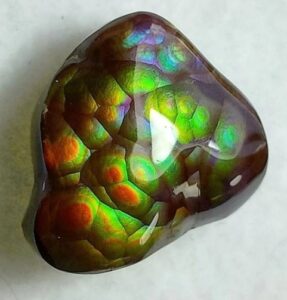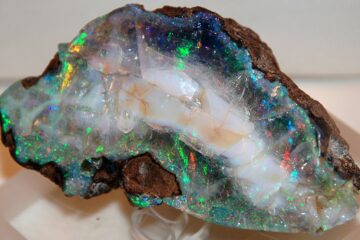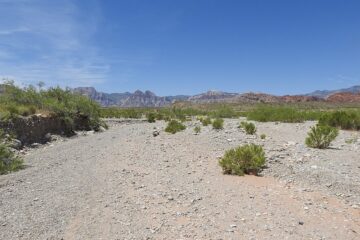Agates are a very fine-grained variety of Chalcedony, which is composed of two silica minerals, quartz, and moganite.
Because agates are so fine grained, (called cryptocrystalline) they take on a very high polish, when worked with lapidary equipment such as rock tumblers and cabbing machines. Agates are also quite hard, measuring 6.5 to 7 on the Mohs hardness scale, which adds to their ability to polish well.
Hand polished agate beads have been found in the Indus Valley, ancient Egypt, and Mesopotamia that date back approximately 5000 years. Agates are mostly found in seams and as nodules within volcanic and metamorphic rocks.
There are quite a few varieties of agates. Probably the most common and well-known, at least in the lapidary world are Brazilian agate and Botswana agate, many tons of these agates have been marketed over the years.
Here in the US, there are also many types of agates to be found. I’ll go over some of the most beautiful and sought after.
Just a note of caution, there are many over-priced, low quality, dyed, and treated agates for sale. Do your research, get to know what the high-quality stones and rough look like. That being said, there are also some good deals to be had.
Fire Agate
Fire Agate is a beautiful and rare variety of agate, the highest quality pieces contain an iridescent fire, in flashes of green, yellow, orange, purple, and blue.
Polished fire agate averages about $20 a carat, although the highest quality blue and purple stones can sell for $1000 a carat, or more. Fire agate and gem silica are the most valuable of all agates.
This “fire” is similar to, but unique from the fire of precious opal. The fire is thought to be caused by the refraction of light between layers of chalcedony and the iron oxide goethite.
Fire agate is only found in northern Mexico, far southeastern California, Arizona, and western New Mexico. There are several areas in the desert southwest where you can hunt for fire agate. See my post Where to find Fire Agate.
Carnelian Agate
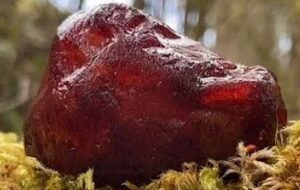
Carnelian agate was a prized gem in ancient times, rivaling in value ruby, emerald and sapphire.
Today carnelian is still a prized stone, although nowadays, a price of 5 to 10 dollars a carat for a finished stone of translucent orange red color would be about right.
Carnelian agate comes in shades from light orange to dark orange red. The most valuable stones are the darker shades that show no banding and are translucent to almost transparent.
There are many gem fields in the southwest where carnelian, although not common, can be found. Highly prized by rockhounds.
Gem Silica
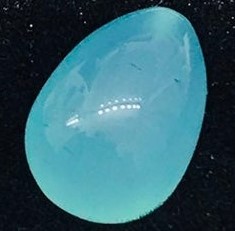
Gem Silica, also known as Gem Silica Chrysocolla is a beautiful and rare form of agate or chalcedony.
The highest quality gem silica is a translucent sky blue color. This coloration is caused by the presence of copper minerals.
Gem Silica is a little-known gemstone and very uncommon. There are places in the southwest where it can be found, especially in Arizona in and around old gold-copper mines and prospects.
It may be found in the presence of other copper minerals such as Azurite, Malachite, and Chrysocolla, which are beautiful and sometimes valuable minerals in their own right.
The best Gem Silica rivals in value the best Fire Agate. Polished Gem Silica of translucent, uniform sky blue, can sell for $100 to $300 a carat.
Crazy Lace Agate

Crazy Lace Agate is very popular with lapidary enthusiasts because of it’s beautiful and intricate lace-like banding.
Lace agates can be found in many areas of the desert southwest. The most popular comes from Mexico though and is prized because of its bright yellows and reds.
Crazy Lace agate found north of the border is predominately grey, white and tan, although still quite beautiful.
Good sized polished cabochons of high quality Mexican crazy lace agate can be bought for 15 to 20 dollars, and good sized rough slabs for $40 to $50.
Moss Agate
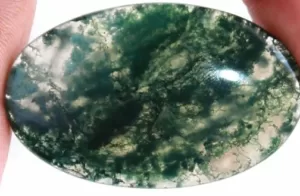 Moss agate comes in a few colors, but green is most common and hence it’s name, resembles moss floating in a translucent background.
Moss agate comes in a few colors, but green is most common and hence it’s name, resembles moss floating in a translucent background.
The “moss” inclusions are caused by the presence of greenish hornblende or chlorite.
Moss agate is low to mid priced, nice quality cabochons can be obtained in the $20 to $40 range.
As with most of the other agates shown here, moss agate can be found at many locales across the southwest.
Banded or Fortification Agate
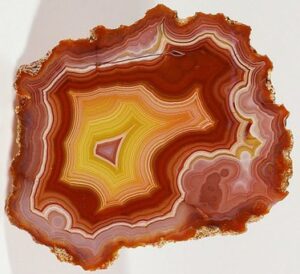 Banded and fortification agates are the true traditional forms of agates. They show separate bands of concentric rings.
Banded and fortification agates are the true traditional forms of agates. They show separate bands of concentric rings.
Banded agates usually form in nodules that when cut with a lapidary saw can reveal many parallel bands of different hues.
Sometimes the center portions can contain intergrown quartz crystals.
Banded agates, especially types such as Brazilian Agate are often sold as polished slabs to show the complete banding.
Banded agate polished slabs can be quite beautiful and affordable. $30 to $60 for a 6″ polished slab would be about the average price point.
Dendritic Agate
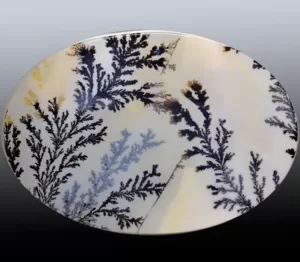 Dendritic Agate is a semi-translucent stone, usually a milky white background with contrasting black inclusions caused by the presence of manganese oxides.
Dendritic Agate is a semi-translucent stone, usually a milky white background with contrasting black inclusions caused by the presence of manganese oxides.
These inclusions can resemble the intricate structure of branches or fern-like patterns.
The dendritic inclusions are mostly two-dimensional, although some higher quality stones may show dendritic patterns on different layers, adding a three dimensional effect.
Grade A dendritic agate cabochons can be quite pricey at $70 to $100 and up.
Sagenite Agate
 Sagenite Agate, or just sagenite is not common, although it can be found in the desert southwest, if one is patient.
Sagenite Agate, or just sagenite is not common, although it can be found in the desert southwest, if one is patient.
Good quality sagenite has a translucent to semi-transparent background, with yellowish tan radiating fans, or sprays of three dimensional needle-like inclusions, caused by the presence of iron and antimony oxides.
High quality sagenite is a rare, beautiful and unique looking agate. Some of the nicest cabochons can sell for $50 to $100 or more.
Plume Agate
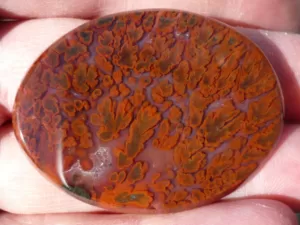 Plume Agate of the best quality contains bright orange-brown inclusions, caused by iron oxides.
Plume Agate of the best quality contains bright orange-brown inclusions, caused by iron oxides.
The inclusions resemble tiny plumes of billowing smoke, or the plumage of an exotic bird.
They appear to be floating on a semi-transparent background.
Plume agate is highly prized by the lapidary enthusiast and rockhound alike. High quality plume agate is the third most valuable agate, after fire agate and gem silica, with good sized cabochons selling for $200 or more.
Turritella Agate
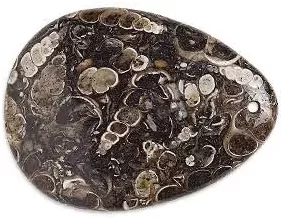 Turritella agate is an opaque stone that contains the small agatized shells of ancient marine life in a fossilized organic matrix.
Turritella agate is an opaque stone that contains the small agatized shells of ancient marine life in a fossilized organic matrix.
Turritella agate is most often polished in rock tumblers.
Turritella can be quite brittle, and is often stabilized using a process involving a lapidary epoxy to strengthen it.
It is one of the least expensive agates, with nice sized polished cabs available in the $10 to $20 range. 1 and 2 lb. bags of Turritella agate pieces, ready for tumbling are also available in the $10 to $20 price range.
